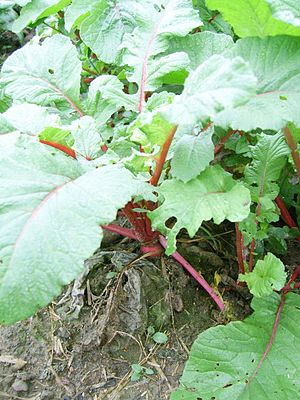Rat tail radish
| Rat tail radish | ||||||||||||
|---|---|---|---|---|---|---|---|---|---|---|---|---|

Radish ( Raphanus sativus ) |
||||||||||||
| Systematics | ||||||||||||
|
||||||||||||
| Scientific name | ||||||||||||
| Raphanus sativus subsp. mougri | ||||||||||||
The rat tail radish ( Raphanus sativus subsp. Mougri ; Syn .: Raphanus sativus L. var. Mougri H.WJ helmet ) and snake radish , peppers radish , Luftradies , Mogri or Mongri called, is a useful plant from the family of the Brassicaceae . It is very closely related to the radish ( Raphanus sativus subsp. Sativus ) and comes from Asia .
Occurrence
The rat tail radish is found in India, Sri Lanka, Myanmar, Thailand, Indonesia and Malaysia.
Taxonomy
The rat tail radish ( Raphanus sativus subsp. Mougri ) has the synonyms Raphanus caudatus L. f. and Raphanus sativus var. caudatus (L. f.) H. Vilm.
use
In contrast to radishes, however, you don't eat the beet , but rather the up to 15 cm long, crunchy pods that are reminiscent of “rat tails” and that are either eaten raw or pickled in vinegar. Its leaves are also used as a vegetable.
Sowing can be done outdoors between April and August. They are grown in rows like radishes. After about seven weeks you can harvest.
Individual evidence
- ↑ Mogri
- ^ A b Raphanus in the Germplasm Resources Information Network (GRIN), USDA , ARS , National Genetic Resources Program. National Germplasm Resources Laboratory, Beltsville, Maryland. Retrieved July 19, 2017.
